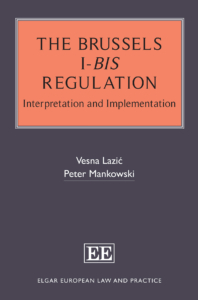Views
Asser’s Enduring Vision: The HCCH Celebrates its 125th Anniversary
By the Permanent Bureau of the Hague Conference on Private International Law
On 12 September 1893, Tobias Asser, Dutch Jurist, Scholar and Statesman, realised a vision: he opened the first Session of the Hague Conference on Private International Law (HCCH). Today, exactly 125 years later, the HCCH celebrates Asser’s vision and the occasion of this First Session with a solemn ceremony in the presence of his Majesty The King Willem-Alexander of the Netherlands. Read more
The race is on: German reference to the CJEU on the interpretation of Art. 14 Rome I Regulation with regard to third-party effects of assignments
By Prof. Dr. Peter Mankowski, University of Hamburg
Sometimes the unexpected simply happens. Rome I aficionados will remember that the entire Rome I project was on the brink of failure since Member States could not agree on the only seemingly technical and arcane issue of the law applicable to the third-party effects of assignments of claims. An agreement to disagree saved the project in the last minute, back then. Of course, this did not make the issue vanish – and this issues concerns billion euro-markets in the financial industry. Read more
German Supreme Court refuses to enforce Polish judgment for violation of the German ordre public
It doesn’t happen too often that a Member State refuses enforcement of a judgment rendered in another Member State for violation of the ordre public. But in a decision published yesterday exactly this happened: The German Supreme Court (Bundesgerichtshof – BGH) refused to recognize and enforce a Polish judgment under the Brussels I Regulation (before the recast) arguing that enforcement would violate the German public policy, notable freedom of speech and freedom of the press as embodied in the German Constitution. With this decision, the highest German court adds to the already difficult debate about atrocities committed by Germans in Poland during WW II.
The facts of the case were as follows:
In 2013, the ZDF (Zweites Deutsches Fernsehen), one of Germany’s main public-service television broadcaster, announced the broadcasting of a documentary about the liberation of the concentration camps Ohrdruf, Buchenwald and Dachau. In the announcement, the camps Majdanek and Auschwitz were described as “Polish extermination camps”. Following a complaint by the Embassy of the Republic of Poland in Berlin, the ZDF changed the text of the announcement to “German extermination camps on Polish territory”. At the same time, the applicant, a Polish citizen and former prisoner of the Auschwitz-Birkenau and Flossenbürg concentration camps, complained to the ZDF claiming that his personal rights had been violated and demanded, among other things, the publication of an apology.
In 2013, the ZDF apologized to the applicant in two letters and expressed its regret. In spring 2016 it also published a correction message expressing its regret for the “careless, false and erroneous wording” and apologising to all people whose feelings had been hurt as a result. At the end of 2016, on the basis of an action he had brought in Poland in 2014, the applicant obtained a second instance judgment of the Cracow Court of Appeal requiring the ZDF to publish an apology on the home page of its website (not just anywhere on the website) for a period of one month expressing its regrets that the announcement from 2013 contained “incorrect wording distorting the history of the Polish people”. The ZDF published the text of the judgment on its home page from December 2016 to January 2017, however, only via a link. The applicant considered this publication to be inadequate and, therefore, sought to have the Polish judgment enforced in Germany.
The Regional Court Mainz as well as the Court of Appeal Koblenz declared the judgment enforceable under the Brussels I Regulation (Reg. 44/2001). The German Federal Supreme Court, however, disagreed. Referring to Article 45 Brussels I Regulation, the Court held that enforcement of the judgment would result in a violation of the German ordre public because the exercise of state power to publish the text of the judgment prepared by the Cracow Court of Appeal would clearly violate the defendant’s right to freedom of speech and freedom of press as embodied in Article 5(1) of the German Constitution (Grundgesetz – GG) as well as the constitutional principle of proportionality.
The Court clarified that the dispute at hand did not concern the defendant’s original announcement – which was incorrect and, therefore, did not enjoy the protection of Article 5(1) GG – but only the requested publication of pre-formulated text. This text – which the ZDF, according to the Cracow court, had to make as its own statement – represented an expression of opinion. It required the ZDF to regret the use of “incorrect wording distorting the history of the Polish people” and to apologize to the applicant for the violation of his personal rights, in particular his national identity (sense of belonging to the Polish people) and his national dignity. To require the ZDF to published a text drafted by someone else as its own opinion would, therefore, violate the ZDF’s fundamental rights under Article 5(1) GG. In addition, it would violate the constitutional principle of proportionality. The defendant had corrected the disputed wording “Polish concentration camps”, which had been available for four days, on the day of the objection by the Embassy of the Republic of Poland. Even before the decision of the Court of Appeal, the ZDF had personally asked the applicant for an apology in two letters and also published an explanatory correction message with a request for apology addressed to all those concerned.
The official press release is available here. The full German decision can be downloaded here.
News
Out Now: The Brussels I-bis Regulation (Lazic & Mankowski)
Vesna Lazic and Peter Mankowski, The Brussels I-bis Regulation: Interpretation and Implementation, Edward Elgar 2023 (602 pp)
This impressive book on the Brussels I-bis Regulation has just been published. It results from a project headed by Vesna Lazic (Utrecht University/T.M.C. Asser Institute) and the late Peter Mankowski (formerly University of Hamburg), in co-operation with Lucia Pein (Hamburg University), entitled ‘Regulation Brussels Ia: a standard for free circulation of judgments and mutual trust in the European Union’ (JUDGTRUST) funded by the European Commission’s Justice Programme (JUST-AG-2017/JUST-JCOO-AG-2017). The research for this project consisted among others of a questionnaire and national reports from all the Member States on the application of the Regulation. This book provides an extensive overview of the CJEU rulings and analysis of case law, which will be of great importance for future reference and the ongoing evaluation and revision of the Brussels I-bis Regulation.
Anchor defendants and exclusive distribution agreements under Article 8(1) of the Bru I bis Regulation – CJEU in Beverage City Polska, C-832/21
How does the anchor defendant mechanism operate in the realm of EU trade marks and actions on trade mark infringement? Is the existence of an exclusive distribution agreement between the defendants sufficient to rely on this mechanism? Those are the questions that the Court of justice addresses in its judgment handed down this morning in the case Beverage City Polska, C-832/21.
Lecture by Prof. Dr. Horatia Muir Watt: “Ecological Jurisprudence: The Shape of Legality at its Own Last Frontier (a Private International Law Approach)” on 27 October 2023 at 17:00 (CEST) at Maastricht University
 On 27 October 2023, the Department of Private Law of Maastricht University (the Netherlands) is hosting a lecture by Prof. Dr. Horatia Muir Watt, Professor at the Sciences Po Law School (Paris), entitled: “Ecological Jurisprudence: The Shape of Legality at its Own Last Frontier (a Private International Law Approach)” at 17:00 (CEST time). This event will take place onsite and in English. For more information, click here.
On 27 October 2023, the Department of Private Law of Maastricht University (the Netherlands) is hosting a lecture by Prof. Dr. Horatia Muir Watt, Professor at the Sciences Po Law School (Paris), entitled: “Ecological Jurisprudence: The Shape of Legality at its Own Last Frontier (a Private International Law Approach)” at 17:00 (CEST time). This event will take place onsite and in English. For more information, click here.



